Vietnam, a country with a rich history, vibrant culture, and stunning landscapes, must be on the itinerary of any avid traveller. Are you looking for the ultimate bucket list of things to do in Vietnam? Well, you’ve landed in the right place! From the misty hills of northern Vietnam to the golden beaches of southern Vietnam, this curated list blends Vietnamese culture, cuisine, and insider tips so you can design a journey that’s seamless, personal, and full of confidence. So, are you ready to embark on an unforgettable trip? Let’s dive in with Designer Journeys!
Post Contents
Prepare for your Vietnam trip
Best time to visit Vietnam
Vietnam’s seasons vary by region, so timing your trip makes all the difference. Northern Vietnam shines from October to April, when the air is crisp, the skies are clear, and trekking in the mountains is at its best. Along the central coast, from Da Nang to Hoi An, February to August brings long days of sunshine, perfect for beach escapes and heritage town exploration. In southern Vietnam, the dry season from December to April is ideal for cruising the Mekong Delta or relaxing on Phu Quoc Island without the interruption of tropical downpours.
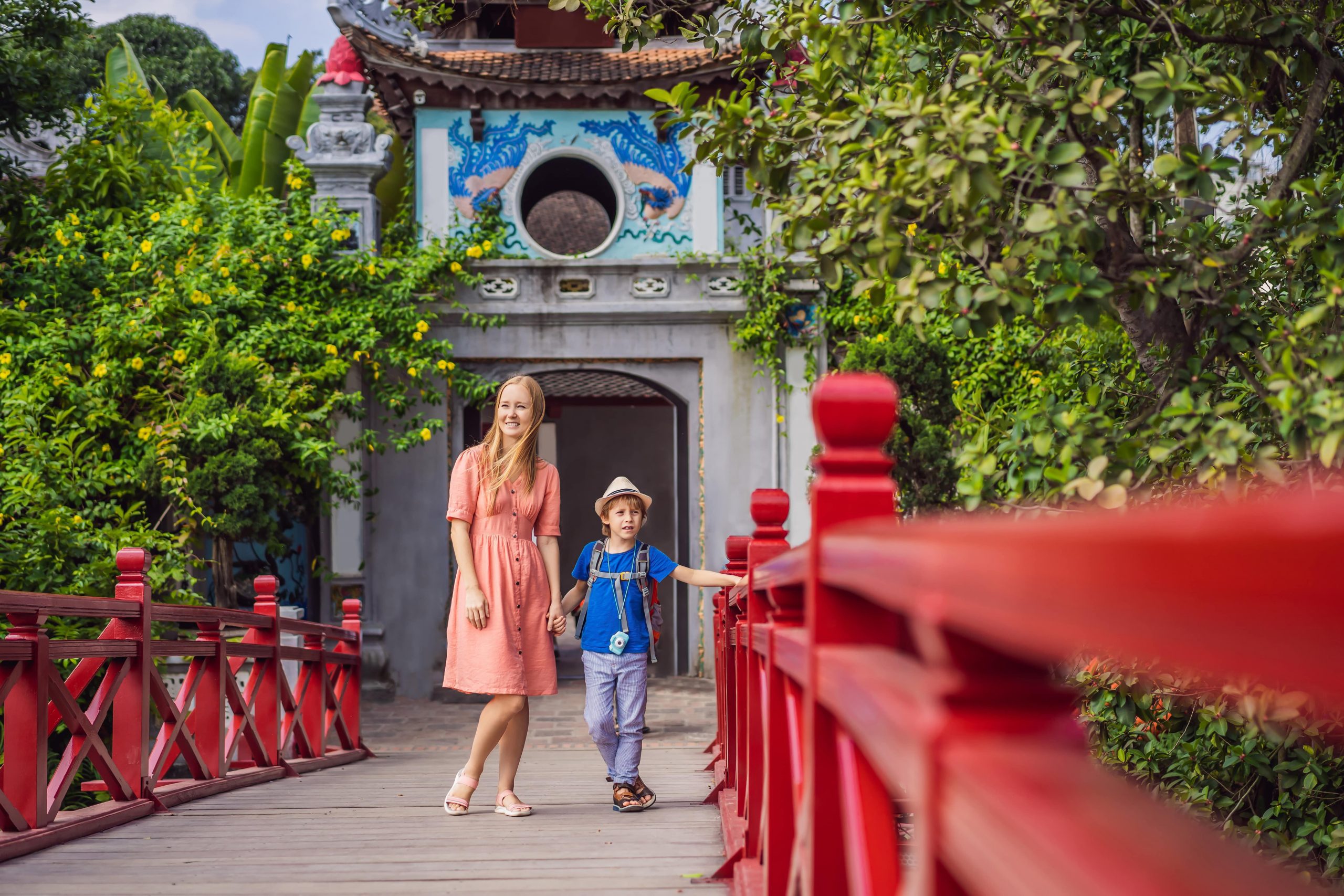
Timing your visit is crucial for having the best experience in Vietnam.
Budget for your trip
A budget of $80–$200 per day gives you flexibility without compromise. At the lower end, you’ll enjoy comfortable hotels, delicious Vietnamese food, and guided tours. For those leaning toward the luxury end, think private transfers, five-star resorts, and exclusive cruise experiences in Ha Long Bay or the Mekong Delta. Vietnam’s value for money is exceptional, allowing you to elevate your journey while still keeping it within reach.
Ideal trip length
While you can catch a glimpse of Vietnam in a week, 10–14 days is the sweet spot for exploring the country from north to south. This timeframe gives you space to balance city adventures in Ho Chi Minh City or Hanoi with time in small towns, national parks, and coastal retreats. It also allows for a natural pace—enough to soak in each destination without feeling rushed.
Are you planning a trip to Vietnam?
Browse our gallery of fully customisable Vietnam itineraries and connect with one of our expert Local Designers to get you started! Designer Journeys can design your ultimate experience and offers hand-crafted itineraries built by experienced Local Designers who have first-hand knowledge of the destination.
Best things to do in Vietnam (2025 Update)
Northern Vietnam
Northern Vietnam, a region brimming with awe-inspiring landscapes, rich cultural heritage, and fascinating history, is a treasure trove for any traveller. When thinking about things to do in Vietnam, the North offers a multitude of experiences that are sure to captivate.
1. Street Food Adventures in Hanoi’s Old Quarter
No trip to Hanoi would be complete without a stroll through the city’s legendary Old Quarter (Phố Cổ), a maze of narrow streets that date back over a thousand years. Known for its vibrant atmosphere, this area is the beating heart of Hanoi, where tradition meets modernity.

Exploring Old Quarter by Cyclo.
Each street in the Old Quarter has its own unique charm, often named after the goods that were historically sold there. The city streets are packed with stalls serving pho, bun cha, and banh cuon. Dine with locals on tiny stools, soaking in the lively atmosphere—it’s the perfect way to experience authentic Vietnamese culture, and a delightful treat for tourists and food enthusiasts alike.
2. Experience Hanoi’s Coffee Culture
Hanoi is renowned for its coffee culture, where traditional Vietnamese coffee is served in unique ways that are both a treat for the senses and a reflection of local ingenuity. Some people say that the morning coffee here is like an art form, from the rich drip brews, French-inspired café au lait, to the unique egg coffee.
One of the city’s most famous drinks is egg coffee (cà phê trứng), a creamy concoction made by whipping egg yolks with sugar, condensed milk, and coffee. This frothy, dessert-like beverage was invented in Hanoi in the 1940s due to a shortage of milk, and it has since become a beloved local speciality.

Egg coffee, one of the Hanoi’s most famous drinks.
Some of the most famous cafes in Hanoi to visit are Cafe Giảng (known as the birthplace of egg coffee, this humble cafe in the Old Quarter is a must-visit for anyone wanting to try this iconic drink), Cộng Caphe (a retro chain offering traditional and modern drinks like coconut coffee), and The Note Coffee (near Hoan Kiem Lake, known for walls of colourful post-it notes left by visitors).
3. Visit Train Street in Hanoi
One of Hanoi’s most unique and exhilarating experiences is visiting Train Street. Located in the city’s heart, this narrow alleyway is where trains pass within mere inches of the surrounding houses. The sight of a speeding train moving through such a tight space is both awe-inspiring and a little nerve-wracking as locals go about their daily lives, only moving aside when the train is about to pass.

People gather at cafes and local shops that line the tracks to witness the train run through.
4. Trekking Through Rice Fields and Green Mountains in Sapa
Sapa is encircled by terraced rice fields and villages of ethnic minorities. The ideal way to experience hill tribe culture is through trekking and homestays. This trekking route passes waterfalls, enjoys cool mountain air, and features locals selling handmade textiles at market towns. The best times to visit are from September to November or March to May.

Scenes from the rice harvest, Mu Cang Chai.
5. Visit Ban Gioc Waterfall
Tucked away in the remote northern reaches of Vietnam lies the Ban Gioc Waterfall (Thác Bản Giốc), one of Southeast Asia’s most stunning natural wonders. It is often referred to as the largest waterfall in Vietnam and the fourth-largest waterfall along a national border. Its pristine beauty, towering limestone cliffs, and lush green surroundings make it an essential stop for nature lovers and those looking for an off-the-beaten-path adventure.

Aerial view of Ban Gioc Waterfall, often referred to as the largest waterfall in Vietnam.
For photography enthusiasts, Ban Gioc Waterfall is a dream come true. The combination of the cascading water, the verdant surroundings, and the dramatic limestone cliffs creates endless opportunities for capturing stunning images.
Expert tip: The best time for photography is early morning or late afternoon when the sunlight is soft. The rainy season, with the waterfall at its most potent, offers dramatic photo opportunities, but the dry season provides captivating images with clear skies and peacefulness.
6. Cruising Ha Long Bay and Cat Ba Island
A UNESCO World Heritage Site, Ha Long Bay is a dreamscape of limestone karsts rising from emerald waters. The name “Ha Long” translates to “Descending Dragon,” reflecting the enchanting local legend that explains the bay’s creation. Ha Long Bay is a truly iconic and awe-inspiring natural wonder. Its emerald waters, towering limestone karsts, and mystical beauty have captured the hearts of visitors from across the globe.

Ha Long Bay is the crown jewel of Vietnam’s natural heritage.
One of the most popular ways to experience is by taking a cruise, which allows you to explore the bay’s many islands, islets, and caves while enjoying the comfort of a boat. Cruises range from day trips to overnight stays on luxury junks, and they often include meals, guided tours, and activities like kayaking and swimming.
Nearby is Cat Ba Island, a treasure that balances untamed beauty with a relaxed, welcoming atmosphere. The island is part of Cat Ba National Park, a sprawling reserve of green mountains, dense forest, and hidden thundering waterfalls. While the bay’s towering limestone karsts and emerald waters draw millions of tourists each year, Cat Ba offers a quieter, more immersive way to experience this UNESCO World Heritage Site.
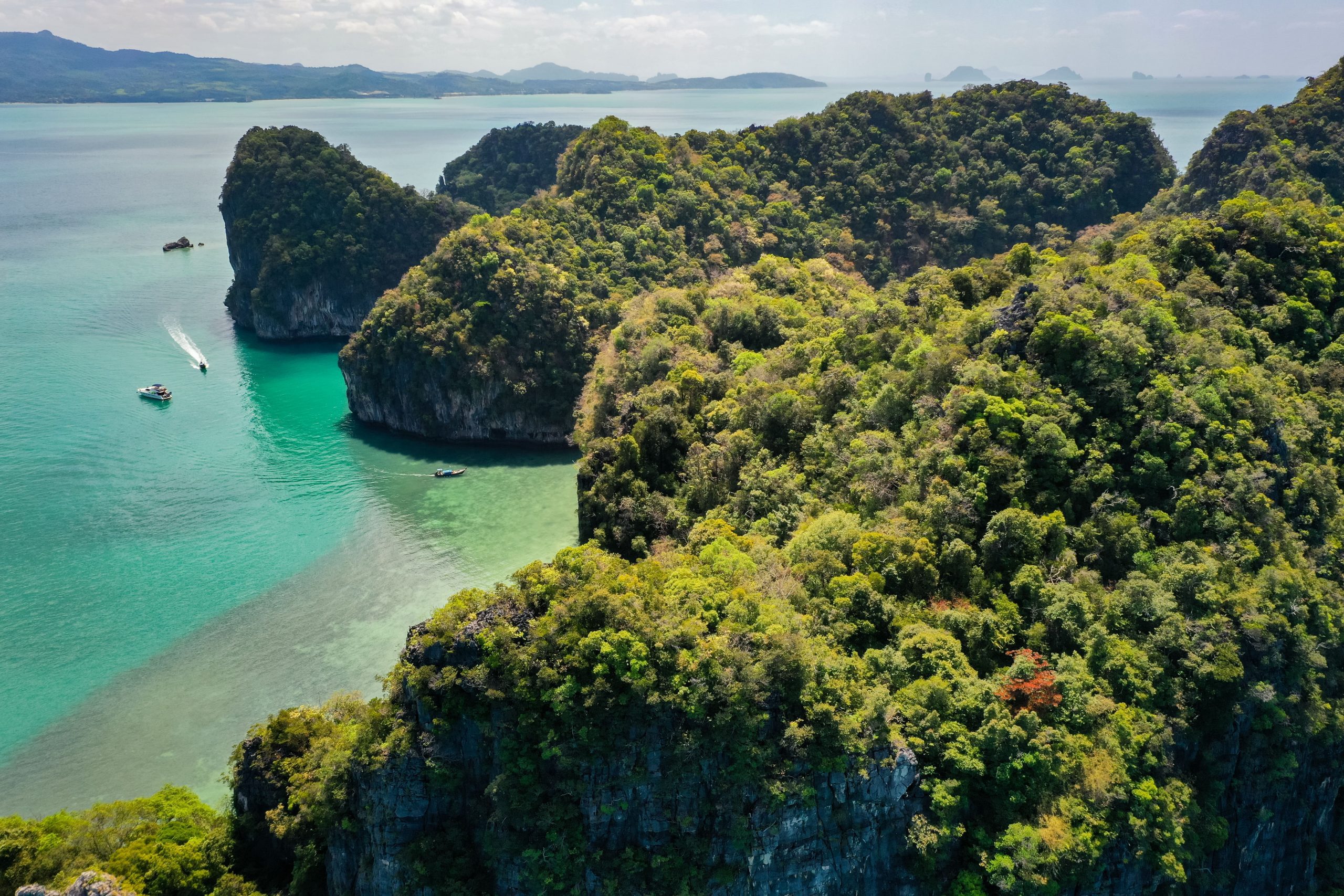
Beautiful view of nature with a calm, blue sea and islands in Cat Ba National Park.
7. Experience Ninh Binh Province: Hoa Lu, Tam Coc
Known as the “Ha Long Bay on land”, Ninh Binh province is one of Vietnam’s most beautiful spots—a landscape where limestone karsts rise from emerald rice paddies, ancient temples stand guard over small towns, and winding rivers cut through hidden valleys. Just two hours south of Hanoi, this destination offers a perfect balance of natural beauty and deep Vietnamese culture.
Begin your visit in Hoa Lu, Vietnam’s first imperial capital, founded in the 10th century. This historic site is surrounded by steep cliffs that acted as natural fortifications during the Dinh and Le dynasties. Walking through its ornate wooden gates, you’ll find temples dedicated to the country’s earliest kings, each filled with intricate carvings and the scent of burning incense—a quiet reminder of Buddhism’s influence in the region.
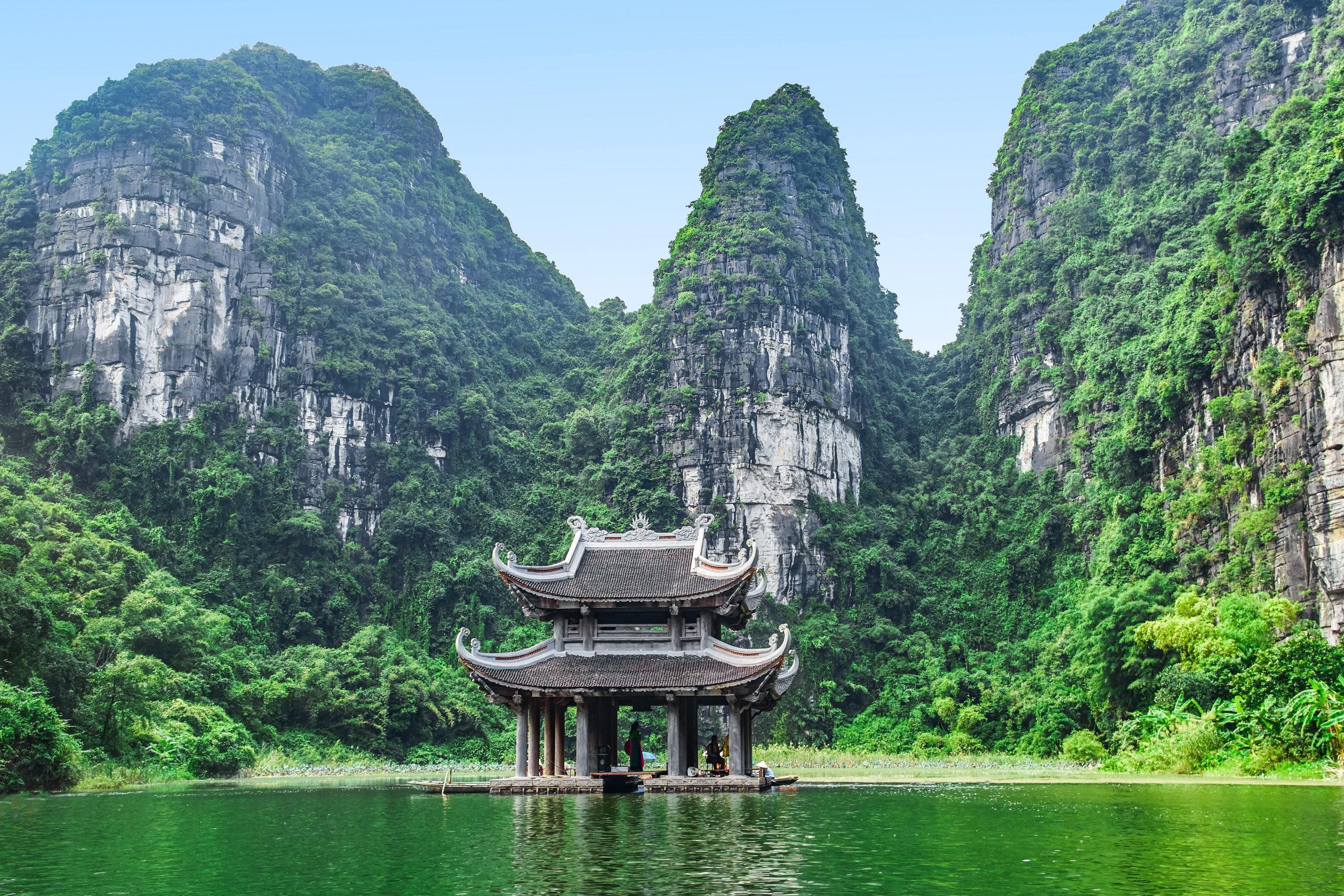
Ninh Binh is known as the “Ha Long Bay on land”.
From there, head to Tam Coc, where the river meanders through a landscape so cinematic it has been used in international films. The best way to explore is by boat, rowed by skilled locals who often use their feet instead of hands to paddle—a charming tradition unique to the area. The journey takes you under limestone arches, through dripping caves, and past rice fields that shimmer in the morning light. In spring, the paddies are lush green; by late May, they turn a golden yellow, ready for harvest.
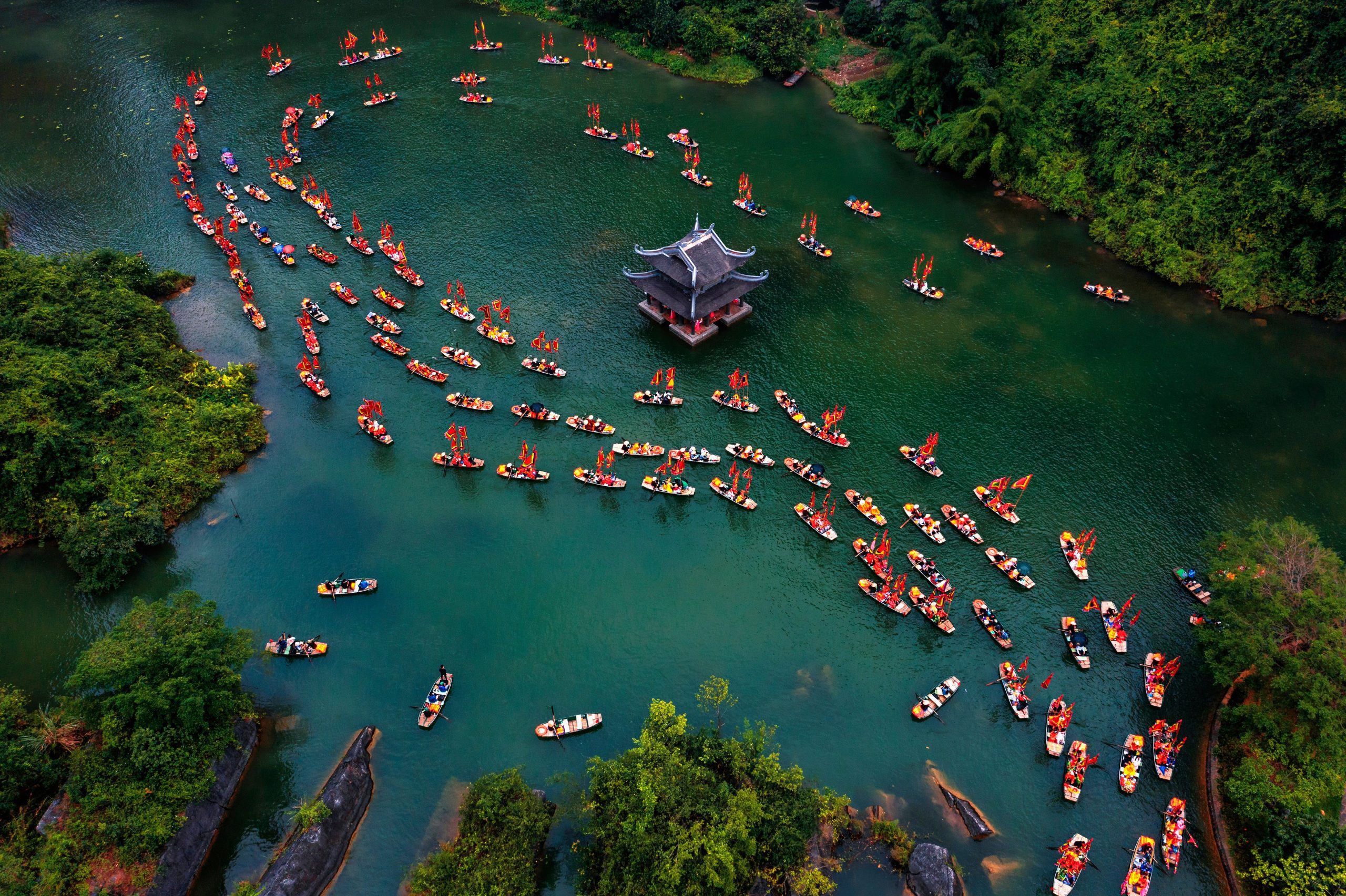
The best way to explore Tam Coc is by boat, rowed by skilled locals.
For the active traveller, climbing the 500 stone steps up to Hang Mua Peak is a must. The reward is a sweeping view over Tam Coc’s winding waterways and limestone karsts—a perspective that captures why this area is often called one of the best things to do in Vietnam. The climb is steep but short, making it accessible for most visitors.
8. Mai Chau’s Small Town Charm
Nestled in a lush valley surrounded by green mountains and misty hills, Mai Chau is the kind of small town where time slows down. Just three hours southwest of Hanoi, this rural escape offers a refreshing change from the busy pace of the city. Here, the rhythm of life is set by the crow of roosters, the chatter of children cycling to school, and the gentle rustle of the wind through golden rice fields.
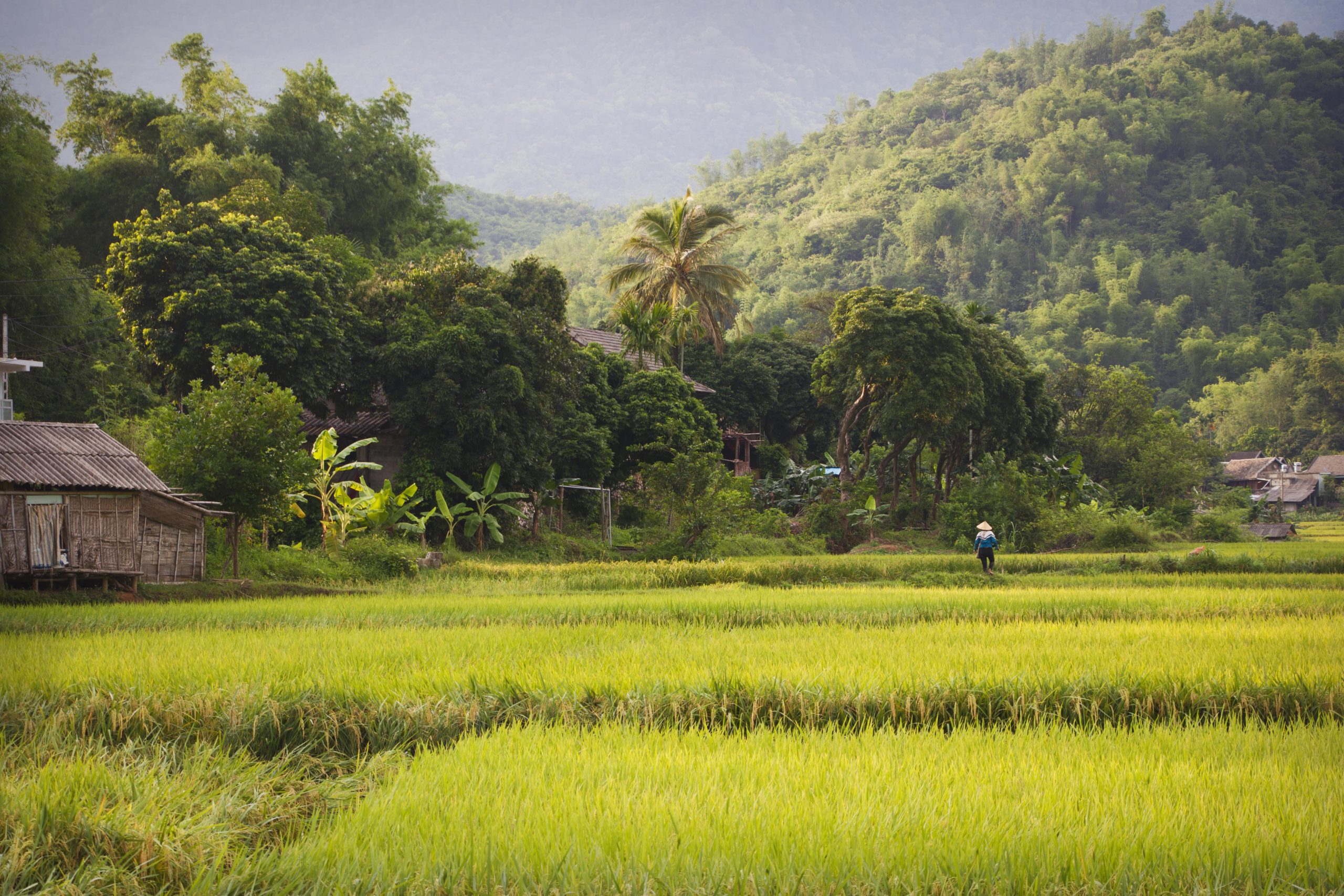
Landscape of Mai Chau with rice field.
One of Mai Chau’s most vibrant highlights is Chợ Phiên Mai Châu, the weekly market that bursts into life every weekend. This market town gathering draws villagers from the surrounding hills, dressed in traditional clothing and carrying woven baskets brimming with produce, textiles, and handmade crafts. It’s a place where locals come to trade and socialise, and where tourists can experience a genuine slice of community life.
Design your perfect Vietnam trip today!
Work with your expert local travel designer to customise your itinerary so it is exactly what you want from a Vietnam trip. Get exclusive experiences, top-rated restaurants, and hotels that fit your interests.
Central Vietnam
Central Vietnam is a region where the coast meets ancient history, where the scent of incense lingers in imperial courtyards, and where river lanterns float quietly under the moonlight. It’s a place of contrasts—serene beaches next to bustling market towns, and timeless UNESCO World Heritage Sites set against dramatic mountains. For many travellers, this part of Vietnam offers the perfect balance of culture, fun, and relaxation.
9. Visit Phong Nha – Ke Bang National Park
Inland from the coast, Phong Nha-Ke Bang National Park is a UNESCO World Heritage Site and home to one of the most extraordinary cave systems in the world.

Hang Son Doong – The world’s largest cave.
The crown jewel is Hang Son Doong, the world’s largest cave, so vast it has its own climate and forest inside. Expeditions here are limited and require advance booking, but even the smaller caves like Paradise and Phong Nha are jaw-dropping in their scale and beauty.
10. Scenic Boat Ride on the Perfume River
The Perfume River (Sông Hương) gracefully flows through the heart of Hue, embodying the city’s essence. Its name comes from the fragrant flowers that drift into the water from nearby orchards in autumn, creating a sweet, floral aroma. A tranquil boat trip along the Perfume River reveals some of Hue’s most cherished landmarks, including the Thien Mu Pagoda and the royal tombs, inspiring a deep appreciation for the city’s rich heritage.

A tranquil boat trip along the Perfume River reveals some of Hue’s most cherished landmarks.
11. Wandering in the Imperial City of Hue
The Imperial City (Kinh thành Huế), also known as the Citadel, is the heart of Hue and was Vietnam’s political, cultural, and religious centre during the Nguyen Dynasty. The Citadel is divided into several sections, including the Imperial Enclosure, where the emperors and their families lived, and the Purple Forbidden City, which was reserved exclusively for the emperor. Though many of the structures were damaged or destroyed during the Vietnam War, restoration efforts have been ongoing, and visitors can now explore the beautifully restored buildings and gardens.

Ngo Mon gate, the main entrance of forbidden Hue Imperial City.
12. Watch the Dragon Bridge breathing fire
One of Da Nang’s most iconic landmarks is the Dragon Bridge (Cầu Rồng), which spans the Han River and is shaped like a giant golden dragon. The dragon comes to life on weekends and holidays, breathing fire and water in a spectacular nighttime display. The bridge is also illuminated with colourful LED lights, making it a popular spot for both locals and tourists to gather in the evenings.

The Dragon Bridge comes to life on weekends, breathing fire and water in a spectacular nighttime display.
13. Taking photos on The Golden Bridge
Located in the Ba Na Hills just outside of Da Nang, the Golden Bridge (Cầu Vàng) is one of the most photographed landmarks in Vietnam. The bridge, which appears to be held up by two massive stone hands, offers stunning views of the surrounding mountains and forests. It has become a symbol of modern Vietnamese design and innovation, attracting visitors from around the world.

The Golden Bridge is one of the most photographed landmarks in Vietnam.
The Ba Na Hills themselves are worth exploring, with their cool mountain climate, lush landscapes, and the Ba Na Hills Resort, which includes cable cars, amusement parks, and French-style villages.
14. Visit Hoi An Ancient Town
Hoi An is one of Vietnam’s most charming and well-preserved historical towns. Once a major trading port in Southeast Asia, Hoi An’s Old Town is a UNESCO World Heritage Site, recognised for its unique blend of Vietnamese, Chinese, Japanese, and European architectural styles.

Hoi An’s Ancient Town is one of the Vietnam UNESCO World Heritage Site.
This small town on the Thu Bon River glows with warm yellows, ancient wooden houses, and the colourful fabrics of tailor shops. On the night of the full moon each month, the Hoi An Lantern Festival transforms the town into a dreamscape. Locals and tourists gather to release thousands of paper lanterns onto the river, their flickering lights reflecting on the water’s surface.
2025 LANTERN FESTIVAL DATES:
| January | February | March | April | May | June |
|---|---|---|---|---|---|
| Jan 13th, 2025 | Feb 11th, 2025 | Mar 13th, 2025 | April 11th, 2025 | May 11th, 2025 | June 9th, 2025 |
| July | August | September | October | November | December |
| July 8th, 2025 | Aug 7th, 2025 | Sep 5th, 2025 | Oct 5th, 2025 | Nov 3rd, 2025 | Dec 3rd, 2025 |
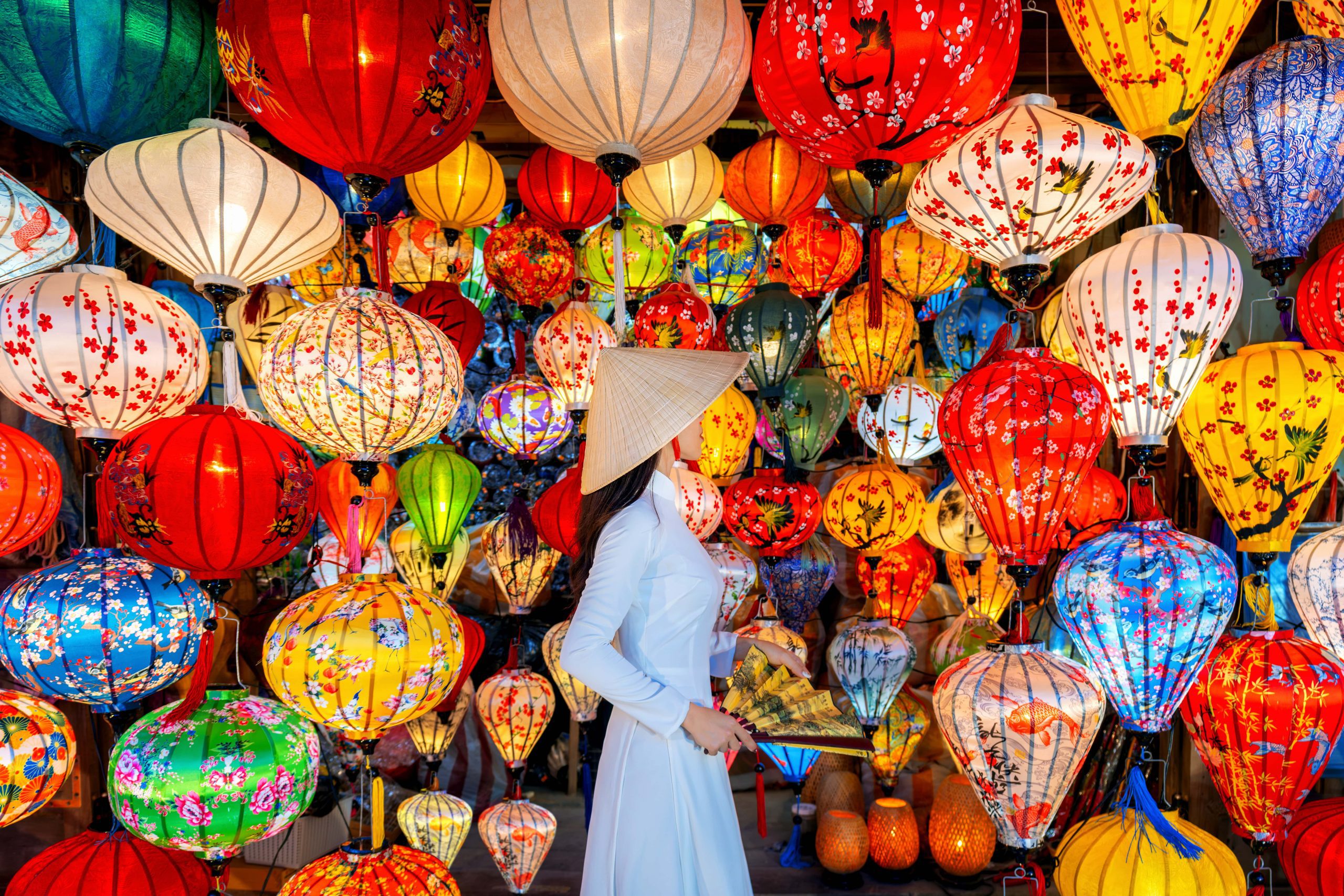
Hoi An Lantern Festival transforms the town into a dreamscape.
While in Hoi An, visit the Japanese Covered Bridge—an iconic symbol of the town’s blend of cultures, built in the 16th century to link the Japanese and Chinese quarters. It’s one of those beautiful spots where history feels alive, and it’s a must for photography lovers.
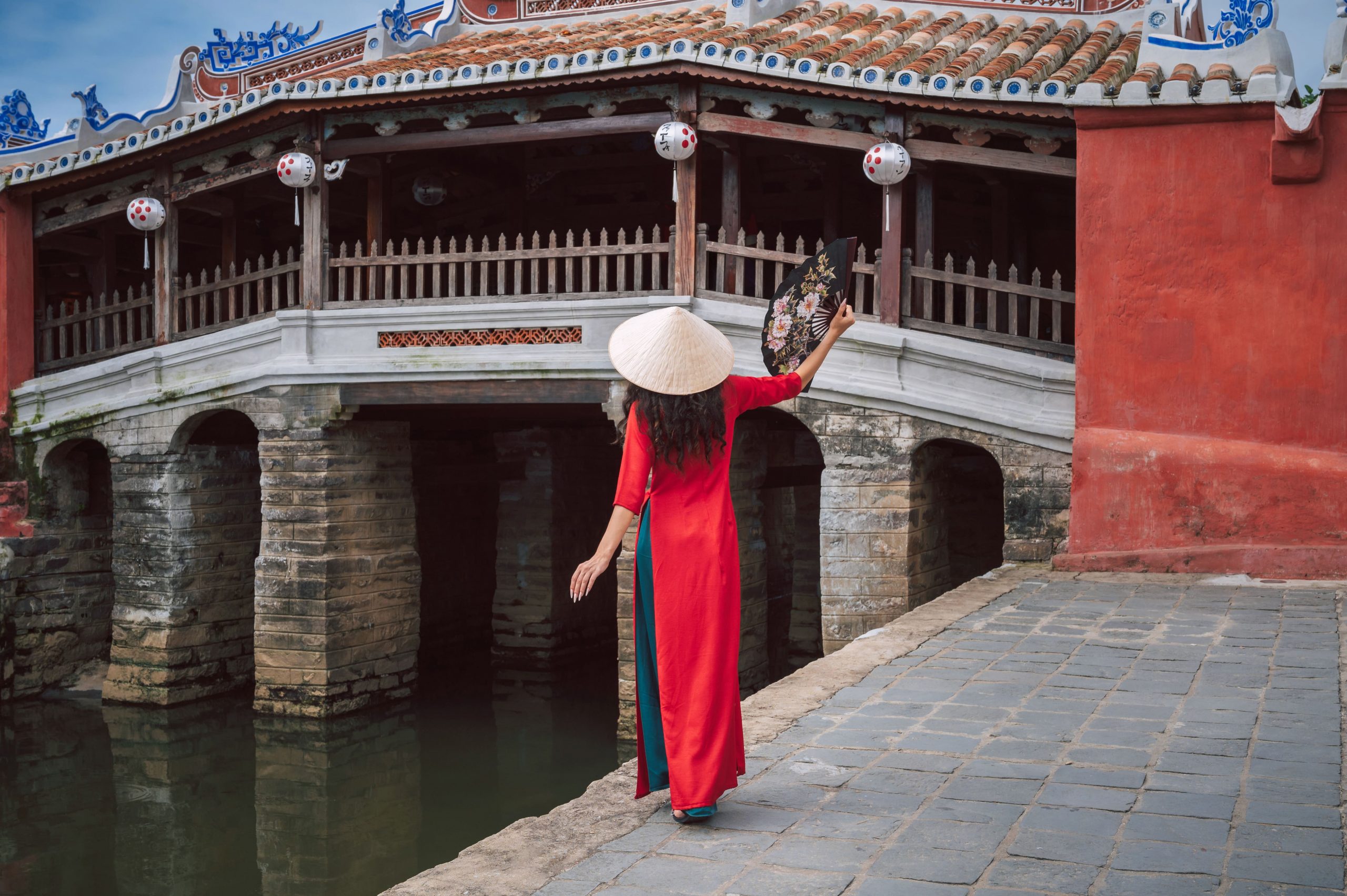
The ancient Japanese covered bridge in old town in Hoi An.
Southern Vietnam
Southern Vietnam is a vibrant and diverse region that contrasts sharply with the country’s northern and central areas. Home to the bustling metropolis of Ho Chi Minh City, the serene waterways of the Mekong Delta, and the tropical island paradise of Phu Quoc, southern Vietnam offers you a wide range of experiences.
15. Visit Ho Chi Minh City
Once known as Saigon, Ho Chi Minh City is the beating heart of southern Vietnam—a mix of sleek skyscrapers, French colonial architecture, and alleyways packed with street food stalls. During the day, explore historic sites like the Central Post Office and Notre Dame Cathedral (The Cathedral has been under renovation since 2017 and will remain closed until 2027) before diving into the sobering history of the Vietnam War at the War Remnants Museum.

The Central Post Office in Ho Chi Minh City.
As the night falls, the city shifts gears. Night scooter tours zip through districts, stopping for sizzling pancakes, steaming bowls of Pho, and sweet iced Vietnamese coffee. The city’s nightlife is vibrant and varied, from rooftop bars with sea breezes to live music venues tucked in hidden corners.
16. Mekong Delta Floating Markets
The Mekong Delta, known as the “Nine Dragon River Delta” (Đồng bằng Sông Cửu Long), is a vast and fertile region where the Mekong River splits into several tributaries before emptying into the South China Sea. Life here is inseparable from the river—it’s the main road, the grocery store, and the meeting place. One of the most iconic attractions in the Mekong Delta is the Cai Rang Floating Market, located near the city of Can Tho. Vendors in wooden boats piled high with pineapples, watermelons, and fragrant herbs call out to customers, often hoisting samples on bamboo poles for easy viewing.

Cai Rang Floating Market is a vibrant display of river-based commerce.
Early morning is the best time to visit, as the market is at its liveliest just after sunrise. Visitors can hire a boat to tour the market, observe the lively trade, and even eat breakfast on the water, sampling the local market specialities like Banh Xeo (Vietnamese pancakes) or freshly cut tropical fruits.
17. Enjoy water activities in Phu Quoc Island
A short flight from Ho Chi Minh City takes you to Phu Quoc Island, famous for its crystal-clear sea, palm-fringed beaches, and production of the country’s best fish sauce. High season runs from December to March, when the skies are clear, the coast is calm, and the island feels like a tropical paradise.

Phu Quoc is the largest island in Vietnam and one of the country’s most sought-after tropical destinations.
Beyond the luxury resorts, you can explore fishing villages or take a boat to the An Thoi archipelago and Turtle Island for unforgettable snorkelling and diving adventures.
18. Hiking in Cat Tien National Park
Just a few hours from Ho Chi Minh City, Cat Tien National Park is a world apart. Its dense forest is alive with rare birds, monkeys, and the occasional call of a gibbon echoing through the canopy. Trails range from short nature walks to full-day treks leading to thundering waterfalls and quiet riverside clearings. Staying overnight in a park lodge lets you hear the forest come alive at night—a magical, humbling experience for nature lovers.
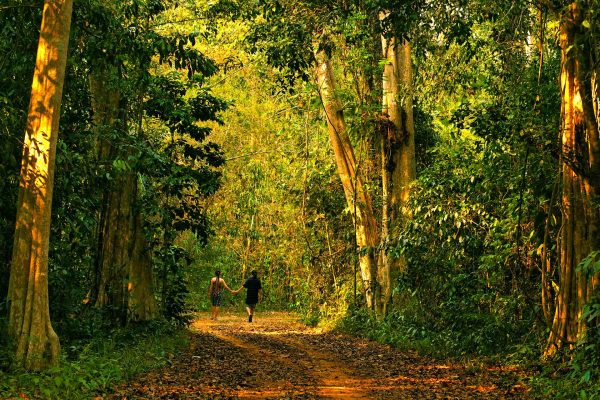
Cat Tien National Park is a world apart.
Image source: Cat Tien National Park
19. Cu Chi Tunnels
A must for history enthusiasts, the Cu Chi Tunnels offer a glimpse into the resilience and ingenuity of locals during the Vietnam War. This vast underground network once stretched for over 200 kilometres, serving as living quarters, supply routes, and hospitals.

The tunnels are an extraordinary testament to the resourcefulness and resilience of the Vietnamese people.
Guided tours explain the complex’s history while allowing visitors to crawl through sections of the tunnels to feel the tight, dark spaces where fighters lived for months on end. Located about 1.5 hours from Ho Chi Minh City, it’s a powerful reminder of Vietnam’s past and the spirit of its people.
Food Cuisine
Vietnamese cuisine, with its delicate flavours, fresh ingredients, and diverse dishes, is a culinary delight that every traveller must experience. When talking about things to do in Vietnam, exploring its food culture is an unmissable activity that offers a delicious journey through its culinary heritage.
Beef Noodle Soup (Pho): This iconic Vietnamese dish, a flavorful soup with rice noodles, herbs, and beef, is a must-try. Enjoying a bowl of Pho is like savouring Vietnam in a bowl.
Pho, the iconic Vietnamese dish.
Banh Mi: This Vietnamese sandwich, a fusion of meats and vegetables from native Vietnamese cuisine, such as chả lụa (pork sausage), coriander leaf (cilantro), cucumber, pickled carrots, and pickled daikon, combined with condiments from French cuisine such as pâté, along with chili and mayonnaise, is a delight for the taste buds.

Banh Mi, a fusion of meats and vegetables from native Vietnamese cuisine.
Goi Cuon (Spring Rolls): These fresh spring rolls, packed with greens, coriander, minced pork, shrimp or crab, and rice vermicelli, served at room temperature, are a refreshing treat.

The fresh (Goi Cuon) spring rolls.
Bun Cha: This Hanoi speciality features grilled pork in a tangy broth with rice noodles and herbs. It’s a flavorful feast.

Bun Cha, the Hanoi speciality features.
Cao Lau: This regional dish from Hoi An, made with noodles, pork, and local greens, is a unique culinary experience.

Cao Lau, the regional dish from Hoi An.
Street Food: Vietnam’s street food culture, with its array of snacks and quick meals, is a gastronomic adventure. From sizzling pancakes (Banh Xeo) to sweet desserts like Che, exploring the street food scene is like a culinary treasure hunt.

Vietnamese street food culture, with an array of snacks and quick meals like Banh Xeo.
Food Stalls: Scattered across the cities and towns, these stalls offer various local dishes. Sampling food from these stalls is like embarking on a local culinary journey.

Sampling food from stalls is like embarking on a local culinary journey.
How to Create Your Ideal Vietnam Trip
Creating your ideal Vietnam trip involves thoughtful planning and consideration of your interests, travel style, and budget. This beautiful country offers many experiences, from exploring bustling cities and historical landmarks to immersing yourself in nature or indulging in the rich culinary scene. Here are some additional tips to help you craft your perfect itinerary:
- Identify Your Interests: Start by identifying your travel interests. Are you drawn to historical sites, vibrant cities, tranquil landscapes, adventurous activities, or culinary experiences? Your interests will help guide your itinerary, ensuring you visit the places and participate in activities that bring you the most enjoyment.
- Research Destinations: Spend time researching the various destinations within Vietnam. Each region has its unique charm and attractions, from the bustling streets of Hanoi to the serene beauty of Halong Bay, the historical richness of Hue and the beaches of Da Nang. Look into what each place offers and align these with your interests.
- Plan Your Itinerary: Based on your research, start planning your itinerary. Consider factors like travel time between destinations, the number of days you wish to spend in each place, and the activities you want to do. A balanced itinerary will allow you to enjoy your trip without feeling rushed.
- Consider the Climate: Vietnam’s climate varies significantly from north to south, with three different climate zones. This variation can affect your travel plans. Research the best time to visit each destination and plan accordingly.
- Book Accommodations: Vietnam offers many accommodations for different budgets and travel styles. You have numerous options, from budget-friendly hostels and homestays to mid-range hotels and luxury resorts. Consider factors like location, amenities, and customer reviews when choosing your accommodation.
- Try Local Cuisine: One of the highlights of any trip to Vietnam is the food. Make sure to try local specialities in each region you visit. Street food tours, cooking classes, and market visits are great ways to explore the culinary culture.
- Respect Local Customs and Traditions: As you immerse yourself in a different culture, it’s important to respect local customs and traditions. This is especially true when visiting religious sites, rural communities, or attending local festivals.
- Stay Flexible: While having a well-planned itinerary is great, stay flexible. Allow room for spontaneous exploration. You might discover a hidden gem, meet interesting locals, or find an activity you hadn’t considered.
- Pack accordingly: Once your itinerary is set, pack accordingly. Essentials should include comfortable clothing and footwear, good-quality sunscreen, a hat, and insect repellent. If you plan on visiting religious sites, be sure to pack appropriate attire.
- Stay Safe: While Vietnam is generally a safe country to visit, it’s always important to stay cautious. Keep an eye on your belongings, especially in crowded places, and be aware of common scams.
F.A.Qs
What activities to do in Vietnam?
Sail Ha Long Bay, trek rice fields in Sapa, visit Hoi An, taste Vietnamese food, explore Ho Chi Minh City, and cruise the Mekong Delta.
Is $100 a day enough for Vietnam?
Yes. $100/day covers hotels, restaurants, and guided tours. Luxury upgrades cost more.
Is 7 days enough for Vietnam?
Yes, for one or two regions—either north for culture or south for beaches and fun.
What is the No. 1 tourist spot in Vietnam?
Ha Long Bay, with its iconic limestone karsts, is Vietnam’s most famous and visited site.
Don’t Miss Our Exclusive Offers! Subscribe Today!
For the ultimate travel inspiration, local insight straight from our expert Local Designers and exclusive offers you won’t find anywhere else from Designer Journeys, sign up today! Don’t miss out.
In conclusion, Vietnam is a country that captivates visitors with its diverse landscapes, rich history, vibrant culture, and delectable cuisine. Whether you’re exploring the bustling cities, immersing yourself in the tranquil beauty of its natural wonders, or embarking on a culinary journey, Vietnam offers many experiences that cater to every interest and travel style. So pack your bags – Don’t just visit Vietnam, experience it! Xin chào, and happy travelling!









